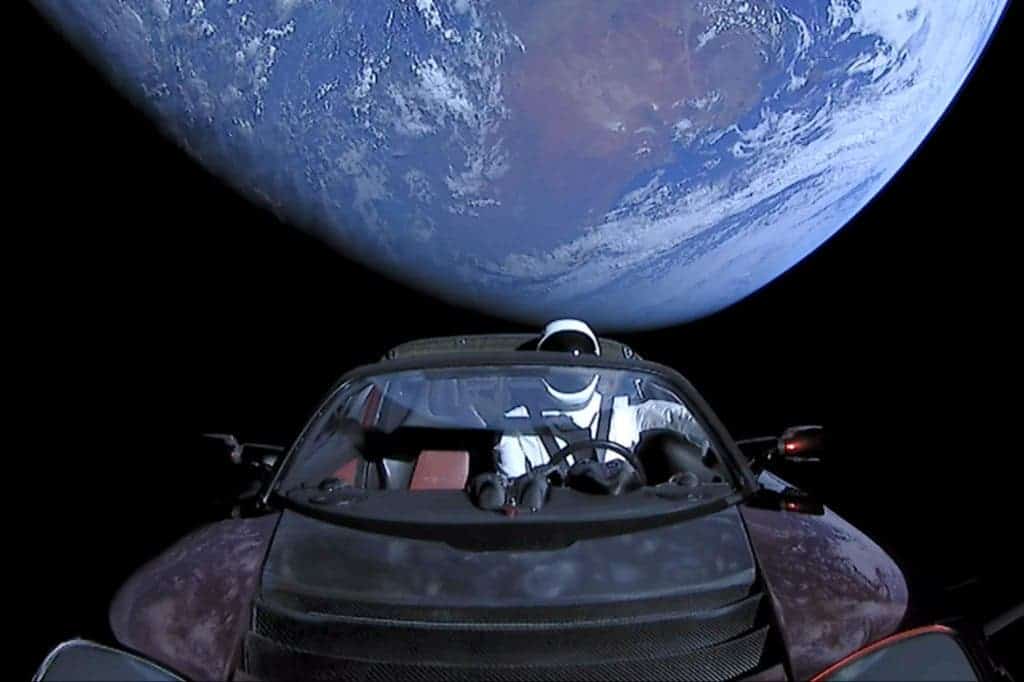Elon Musk’s personal cherry red Tesla Roadster that was recently shot into space on the most powerful operational rocket in the world will eventually collide with Earth or Venus — but that’s millions of years from now.
The car and an onboard dummy named “Starman” acted as a test payload for SpaceX’s Falcon Heavy test flight on February 6. Not only was the launch a resounding success, with two of the reusable side boosters making a perfect, synchronized soft landing, it also provided both SpaceX and Tesla with great publicity.
Third burn successful. Exceeded Mars orbit and kept going to the Asteroid Belt. pic.twitter.com/bKhRN73WHF
— Elon Musk (@elonmusk) February 7, 2018
Right now, the Roadster is set on crossing orbit between Earth and Mars, which will see it travel on an elliptical path beyond Mars and then back to Earth’s orbital distance from the sun. Each time the car comes close to Earth, it will get a gravitational kick that will send it into a wider or smaller obit. Over multiple iterations, Elon’s Roadster could end up on a pretty wild orbit — but where to?
It’s possible to rather easily determine where the roadster will end over a couple of orbital cycles. The thing is that there are so many variables that it becomes almost impossible to precisely predict where the car will end up after a certain number of cycles. It’s just like weather forecasting — scientists can come up with a fairly accurate forecast for tomorrow but for each additional day, the projection deviates from reality more and more.
You might have heard of the “butterfly effect”, which is to say that a small change in one state of a deterministic nonlinear system can result in large differences in a later state. Over time, minute changes compound so much that the expected outcome wildly differs from what you actually get. That’s why the weather forecast seven days in advance is not very accurate — but it’s still better than flipping a coin.
And just like weather forecasters perform dozens of parallel simulations and pick the likeliest outcome, physicists at the University of Toronto Scarborough studied a large number of simulations and arrived at a statistical distribution of possible outcomes. Their analysis suggests that the Tesla Roadster will collide with Earth or Venus over the next million years with a probability of 6 percent and 2.5 percent, respectively. That’s about what scientists expect from the class of small bodies on Earth-crossing orbits termed Near-Earth Objects, or NEOs.
There's two reasons the Roadster's orbit is very uncertain compared to solar system spacecraft
(1) No radio transmissions, so it can't be tracked.
(2) No *intentional* trajectory (at least one reported) beyond "as far as possible"At this point it's basically an asteroid. https://t.co/Rzz3CYdDH7
— Emily Lakdawalla (@elakdawalla) February 8, 2018
The first close encounter with Earth that the Tesla will have will be in 2091 when simulations suggest it will pass within few hundred thousand kilometers of the planet.
“Each time it passes Earth, the car will get a gravitational kick,” says Dan Tamayo, a postdoctoral fellow at U of T Scarborough who is a co-author on the paper that has yet to be published.
“Although we are not able to tell on which planet the car will ultimately end up, we’re comfortable saying it won’t survive in space for more than a few tens of millions of years,” he says.
Tamayo and Hanno Rein, also a physicist at U of T Scarborough, only calculated the Tesla’s trajectory for the next three million years but the two are confident that the most likely outcome for the electric car is to crash into Earth or Venus in about ten million years. There’s an 11-percent chance of it smashing into Earth after three million years.
If it does crash into Earth, there would be no danger since the Tesla won’t be able to survive atmospheric re-entry.
This is all actually very good news for many scientists who were concerned the Tesla might crash into Mars, contaminating it with Earth microbes. And what’s more, the car might not even get a chance to crash into Earth in the first place. According to Tom Narita, an astrophysicist at the College of the Holy Cross in Massachusetts, the Roadster could be obliterated by high-speed space dust and cosmic ray radiation. In only a couple of years, all the plastic and rubber in the car should get shred into pieces by radiation while the metal structure itself can last for hundreds of thousands of years.










